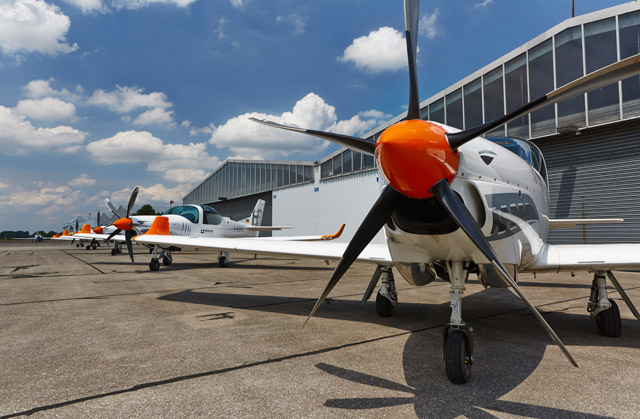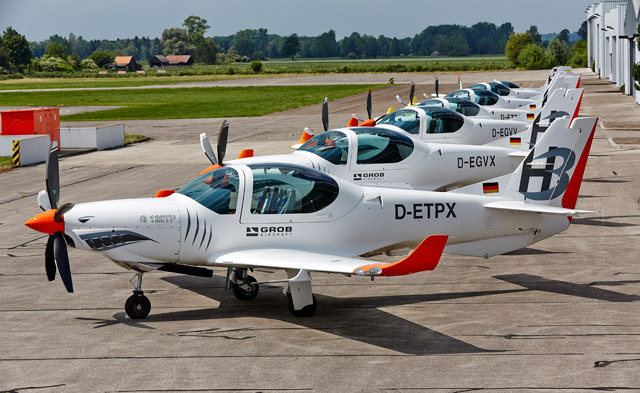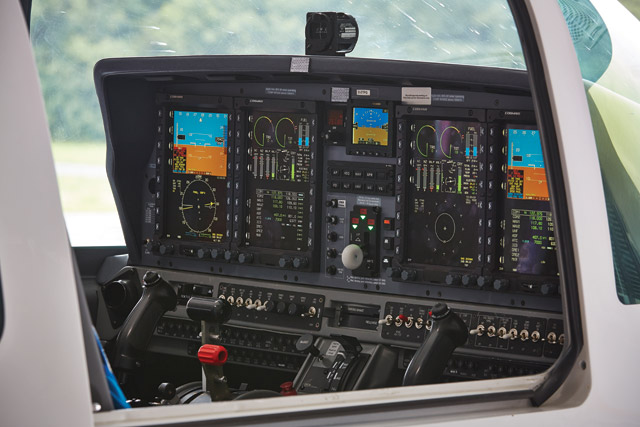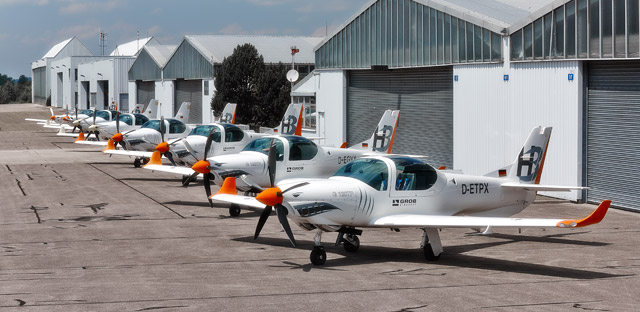Flightglobal was given the opportunity to visit Grob Aircraft at its Mattsies-Tussenhausen production facility in Bavaria, Germany, to evaluate the full digital cockpit of the latest version of its G120TP military trainer.
The G120TP impressed me greatly when I tested it in prototype form in late 2010. Its blend of high performance, low acquisition or lease price, minimal operating costs and considerable training potential was clearly evident. I predicted then that the aircraft was destined to become the new flight, attack and systems trainer of choice for air force training organisations worldwide.
Additionally, the G120TP incorporates a "systems of systems" training concept. I believed it would make the present definitions of grading, elementary, basic and advanced lead-in training phases redundant, and had the potential to revolutionise future military training standards – beginning from a student’s first day.

Grob Aircraft
The aircraft gained EASA CS 23 certification in early 2013, and is on course to gain FAR 23 certification from the US Federal Aviation Administration in early 2015. Since clinching EASA certification, the aircraft has been bought by Indonesia (24, plus eight options), Argentina (10, plus five options) and Mexico (25, plus 15 options). There is also the prospect of a significant order soon from a major European air force. If confirmed, this order would see the aircraft become a breakthrough success.
The initial EASA CS 23 certification basis for the G120TP was with an analogue cockpit, and the new digital cockpit will be classed as a “major change” to the aircraft’s type certificate under the agency’s regulations.
The major change will cover either an option for a two-screen digital display – to one cockpit side, with analogue instruments retained on the other – or an option for a full, four-screen digital display. The latter would endow the G120TP with a complete glass cockpit and, for the first time, provide individual side-by-side cockpits for both student and instructor – as opposed to side-by-side seating.
Grob believes the four-screen digital display will be the most popular option, and it was this configuration I evaluated on the ground at the company facility. Grob was expecting togain EASA certification for its new digital cockpit options in July.

Grob Aircraft
In terms of limitations, the new aircraft standard is virtually unchanged from the prototype. Maximum operating airspeed is now 238kt (440km/h) indicated – against a previous 245kt – and maximum take-off weight is 1,520kg (3,350lb); down from 1,590kg.
Improvements include new undercarriage that allows the G120TP to sit level, rather than the prototype’s tendency to sit slightly tail down.
The external power connection point is now behind the right wing root; the gaseous oxygen bottle and system is fully enclosed within the baggage area and the oxygen hose and microphone-telecommunication connections have been simplified and tidied.
The flap lever has been remodelled and has four positions (up/take-off/land/full) and the power lever features a pilot-selectable mechanical “detent” – which can be overridden – set to approximately 230shp (171kW), for initial student grading and circuit flying. The new variant also features electric trim in all three axis, and pitch trim is shown as a “green band” within the engine indicating and crew alerting system (EICAS) display.
The manufacturer decided not to progress with a helmet-mounted display system, as most air force customers did not want this option at the early student experience level.
Additionally, new Martin-Baker Mk17 zero-60 (0ft-60kt) lightweight ejection seats are not presently to be fitted. This requirement is on an engineering hold only, however, and remains a firmly defined future option for the G120TP-X upgrade. This package will include increased weight, strengthened wings – with four hardpoints – and more powerful engine variants. Grob is expecting G120TP-X deliveries to commence in late 2016 or early 2017.
With superb aerodynamics and a light weight, due to its carbonfibre construction, plus outstanding jet-like performance and economy – delivered by its 450shp Rolls-Royce 250-B17F turboprop engine, married to a five-bladed, short span MT propeller – the critical element in the role of the G120TP as a 21st century trainer was always going to be a truly advanced digital cockpit.
This addition would make the trainer fit seamlessly with other modern, business-type fixed-wing aircraft and helicopters, acting in the advanced training role for transport and rotary-wing students. It would also fit well with higher performance turboprop trainers, such as the Beechcraft T-6C and Pilatus PC-21, and top-end lead-in fighter trainers such as the Alenia Aermacchi M-346 or BAE Systems Hawk T2 for fighter pilot training.

Grob Aircraft
The G120TP’s cockpit features four screens side-by-side, each 6x8in – 10.4in diagonally – set “portrait” style. Each pilot’s pair of screens is separated centrally by a large combined digital standby attitude indicator, UHF radio panel, autopilot panel, gear panel and three function and warning buttons.
A standby compass is the only instrument on top of the cockpit glareshield, and is set centrally. The digital screens and autopilot are made by Genesys Aerosystems – formally part of Cobham.
Each screen functions as two separate display areas, split upper and lower – up to eight individual screens in total. Each display unit is identical and interchangeable as a hardware unit, and includes the functions of an integrated flight management system (FMS) with area navigation, a terrain awareness warning system and a digital flight recorder. Connected sensors include a GPS module and an air data and heading attitude reference system. The information from the individual avionic units to the screens is carried primarily by an ARINC 429 databus.
Instructor pilot and student displays can be separated as two independent systems or joined together as a single system with a panel-mounted switch. When joined, either side can be synchronised, with the other as the master. The two centre displays are nominated for virtual training modes – such as the embedded simulation of air-to-air radar or tactical air situation display – and display full-screen. When not in this mode, the two inner screens are nominated as the multifunction displays, then with split displays. The two outer screens are always nominated as the primary flight displays (PFDs).
The top half of each outer screen PFD is fixed, and will always carry the primary flight information (PFI) display. This can be set to feature either conventional analogue dials or the more modern vertical tape depiction of altitude, airspeed, vertical speed and heading. Basic flight information is combined with a synthetic grid depiction of terrain or “highway in the sky” flight guidance, with course deviation indicator, flight path vector and aircraft attitude reference symbology.
The other six screens can display a moving map – including terrain, terrain awareness, landmarks and flightplanned route. They can also show a waypoint horizontal situation indicator (HSI) for basic display of VOR, ADF and FMS waypoint bearing needles, shown in a compass rose format.
A NAVLOG overview page acting as a FMS can also be selected, alongside an audio/radio page combining VHF/UHF/transponder/navigation/intercom, a traffic alerting and collision avoidance system (TCAS) and EICAS information. Stormscope display is also an option.
By standard operating procedure, one display screen will always carry the EICAS page. Significantly, the avionics, autopilot and displays will be certificated for vertical navigation flightpath functions and satellite-based approach system approaches, replicating instrument landing system-type guidance to ILS limits, at austere airfields.
On seeing the cockpit for the first time – especially when the screens were already powered up – my impression was of a totally glass cockpit that completely filled the instrument console area. The set-up was a displayed screen area not only unmatched in this class of trainer, but one that also exceeds most – if not all – of the systems advanced modern trainers presently use.
The glareshield has been lowered by 22mm on the production version compared to the prototype, so field of view over the nose was excellent. The view was not compromised by fitting the four screens and having to then configure the other cockpit controls and indicators – such as autopilot panel and warning panel – around them.
My second impression was of a cockpit with a wealth of digital information. The eight screens can be configured exactly for what the student or instructor pilot wants – and on which side of the cockpit for a particular flight or training event.
It is hard to convey just how flexible the display variations are, or how easy it was to configure the cockpit in a way I would want or expect for any future transport, helicopter or fighter-graded student. I also reminded myself that individual screens were not locked into individual display modes, but could be placed anywhere – with the exception of the PFI on the two outer PFD upper displays.
The screens’ display resolution was high and displayed symbols, numbers and letters were easy to read. At least eight different colours are used, with some – such as blue and green – having multiple shades for applications like terrain and landmark presentation. The clarity of any displayed mode and the ease of interpretation by a pilot, even from the 6x4in half-display, are superb – equal to any other modern aircraft with digital displays I have evaluated.
I especially liked the miniature “screen-in-screen” displays that could be selected within the PFI, and the presentation of the highway in the sky flight guidance and synthetic grid ground overlay. These advanced functions are made even more impressive by the fact they are part of a trainer aircraft students will encounter from their very first training day.
Each screen has eight line select keys (LSK) per side, and four rotary knobs along the base. Of the latter, the two on the right are pushed to select either top or bottom display, and turned to change values. The LSK functions change depending on the display mode selected.
The beauty of the Genesys Aerosystems screens is the ease by which you can go back to correct mistakes or change values after input, just as it was to go forward to complete screen setup. This is an important training factor for students flying under pressure in the cockpit.
I estimate I was comfortable to configure and operate the cockpit within 60min of sitting in the aircraft – despite being given no prior briefing.
The prototype G120TP was impressive during my 2010 evaluation, but the latest four-screen digital display production version – allied to an embedded cockpit training simulation – means the type has become the 21st century trainer aircraft the early prototype promised it would be.
This aircraft has amazing training potential, coupled with jet-like performance and incredible value for money.

Grob Aircraft
In my opinion, the G120TP is a breakthrough aircraft. It features true side-by-side cockpits and can realistically span the present definitions of grading, elementary, basic and advanced lead-in phases.
The type can do this for transport, rotary or fast jet students, all at the same time, all to the same standard and all in the most cost-effective manner.
The G120TP offers any modern air force the chance to reshape their training programme.
I continue to predict that the G120TP will set the benchmark for 21st century trainer aircraft worldwide in this aircraft category.
Source: Flight International























